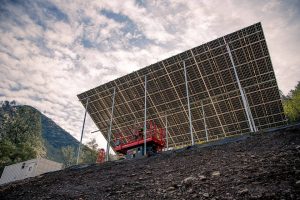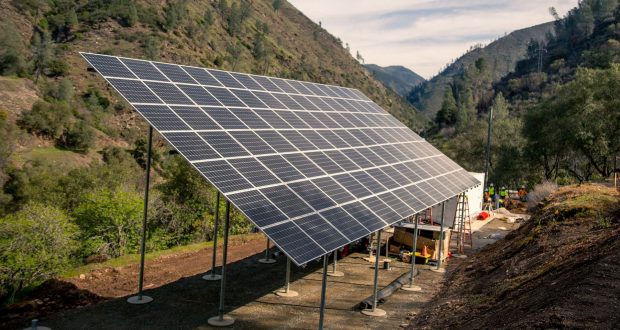A new hybrid-renewable microgrid system that is in development in Briceburg, CA – the first of its kind through PG&E’s new Remote Grid Initiative.
MARIPOSA COUNTY – PG&E and project developer BoxPower.io recently began construction on the Briceburg Remote Grid. PG&E anticipates the system will be completed and online this month as is noted in a press release that BoxPower issued: BoxPower Provides Remote Grid System to Help Mitigate Fire Risk in California
As is detailed in PG&E’s 2021 Wildfire Mitigation Plan, a Standalone Power System (SPS), or Remote Grid, is a new utility service concept that PG&E is developing using decentralized energy sources and utility infrastructure for permanent energy supply to remote customers as an alternative to energy supply through hardened traditional utility infrastructure.
 Standalone Power Systems, which are fully islanded at all times and do not interact with the larger grid, are distinct from microgrids which are grid connected.
Standalone Power Systems, which are fully islanded at all times and do not interact with the larger grid, are distinct from microgrids which are grid connected.
Throughout PG&E’s service area, there are pockets of isolated small customer loads that are currently served via long electric distribution lines. In many circumstances, these lines traverse through High Fire Threat District areas. If these long distribution lines were removed and the customers served from a local and decentralized energy source, the resulting reduction in overhead lines could reduce fire ignition risk as an alternative to or in conjunction with system hardening.
PG&E is eager to deliver these benefits to its customers and is starting the process by providing initial Remote Grid services to willing customers and using the results of those initial installations to refine Remote Grid costs and technology configurations.
PG&E is exploring initial Remote Grid projects as a test bed for developing policies, tariff structures, and operating procedures necessary to integrate remote grids as a feasible product for wires elimination.
In Mariposa County, five customer meters lost power in the Briceburg Fire of 2019 when the line serving them was destroyed. The historical line route is challenging to rebuild through the last 1.3 miles of rugged, High Fire Threat District terrain.
PG&E is deploying a hybrid renewable stand-alone power system to energize the isolated customers. This option will reliably repower these customers without the need to rebuild the overhead line, and the Remote Grid could meet the customer needs at lower lifetime cost and lower risk of future fire.
This remote grid system, currently in development and slated for commissioning in April 2021, is being designed, installed, and operated by BoxPower and owned by PG&E. It has a solar array consisting of a nominal PV power of 36.5 kW and a 69.12 kWh lithium ferro phosphate battery bank. It includes 27.2 kW of continuous power output and a surge capacity of up to 48 kW. The system has two integrated 35 kVA propane prime power generators and a fire suppression system to protect the hardware.
PG&E and BoxPower will be able to monitor and control the system via satellite, with remote performance monitoring, reporting, and automated fuel delivery capabilities.
Ultimately, this (along with a couple other) initial Remote Grid projects will enable PG&E to determine an appropriate expansion of Remote Grid using SPSs to serve remote customers at the same or higher levels of reliability than they have experienced in the past with a lower risk profile and at a lower total cost to distribution customers.
Per the 2021 Wildfire Mitigation plan, PG&E is targeting 20 operational remote grid sites by the end of 2022.
Additional sites in El Dorado, Madera, Fresno, Tulare, Santa Barbara, Yuba, and Sierra counties are currently being assessed.



